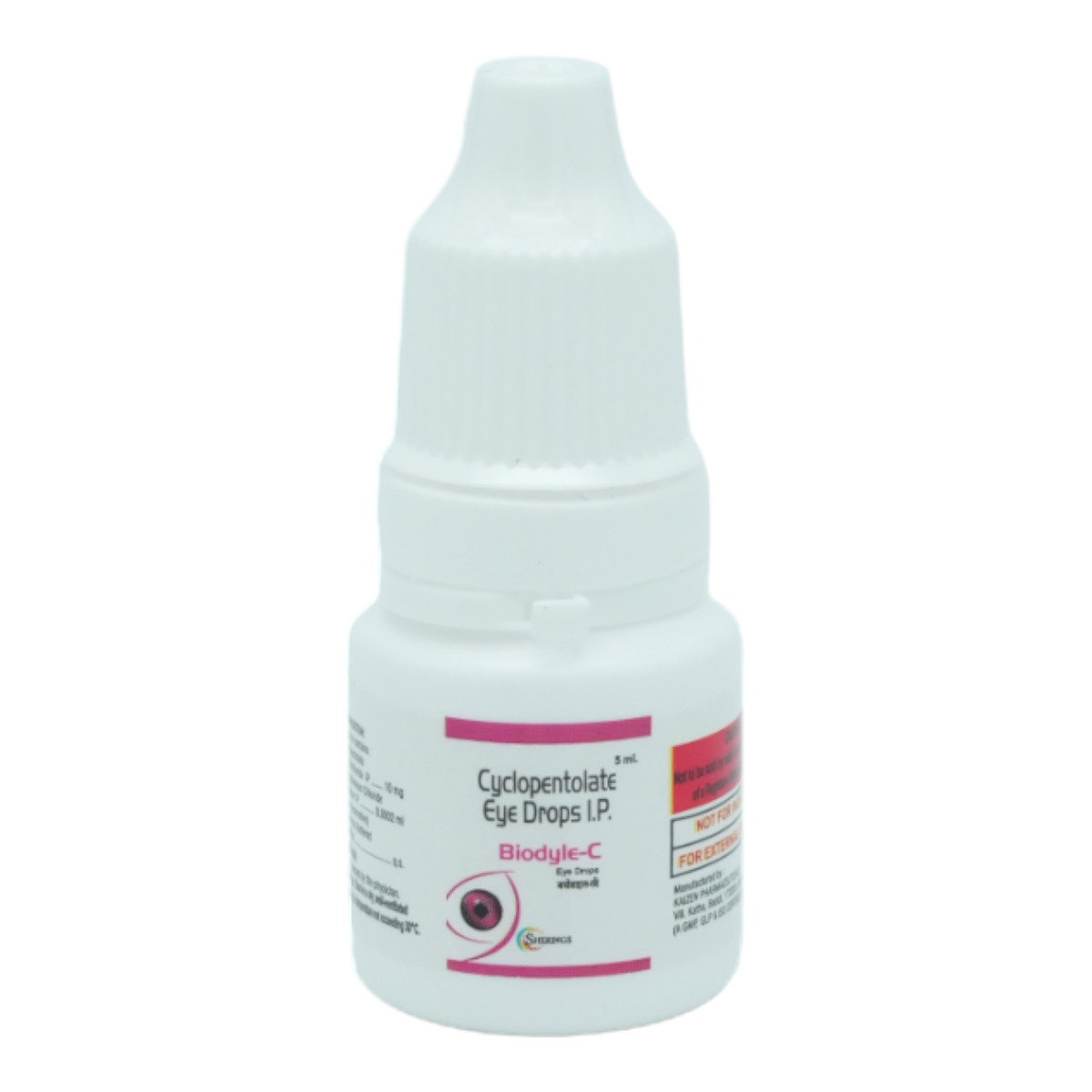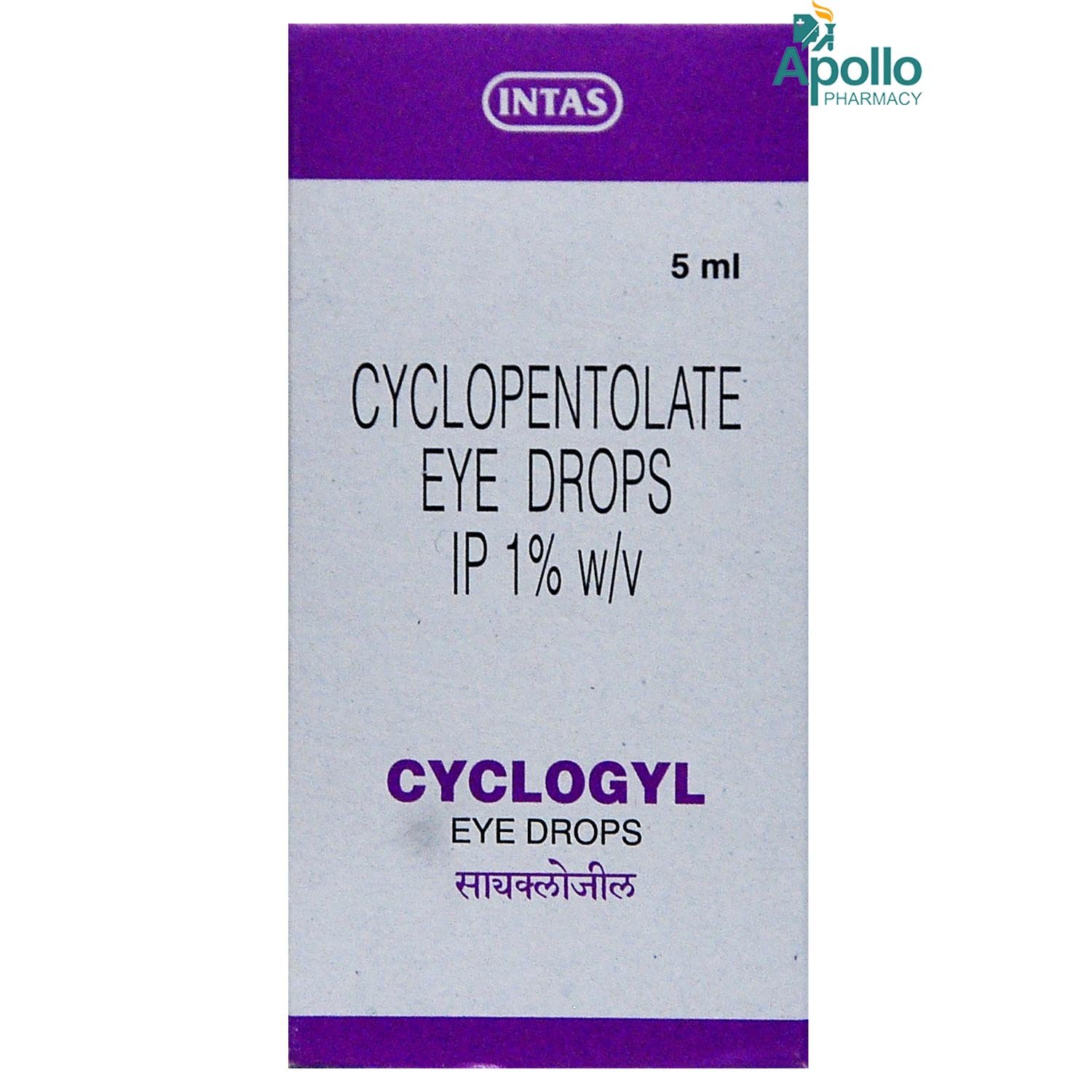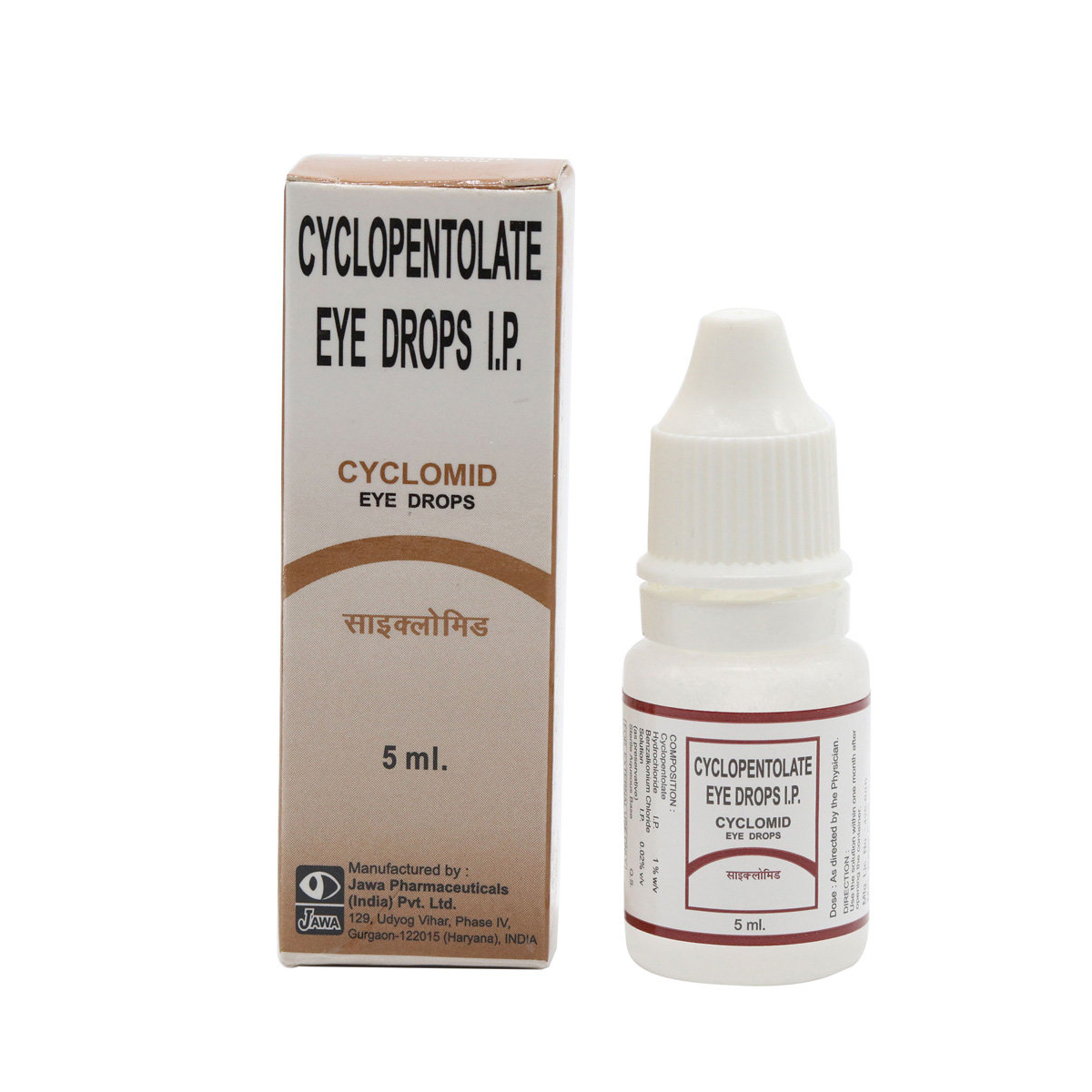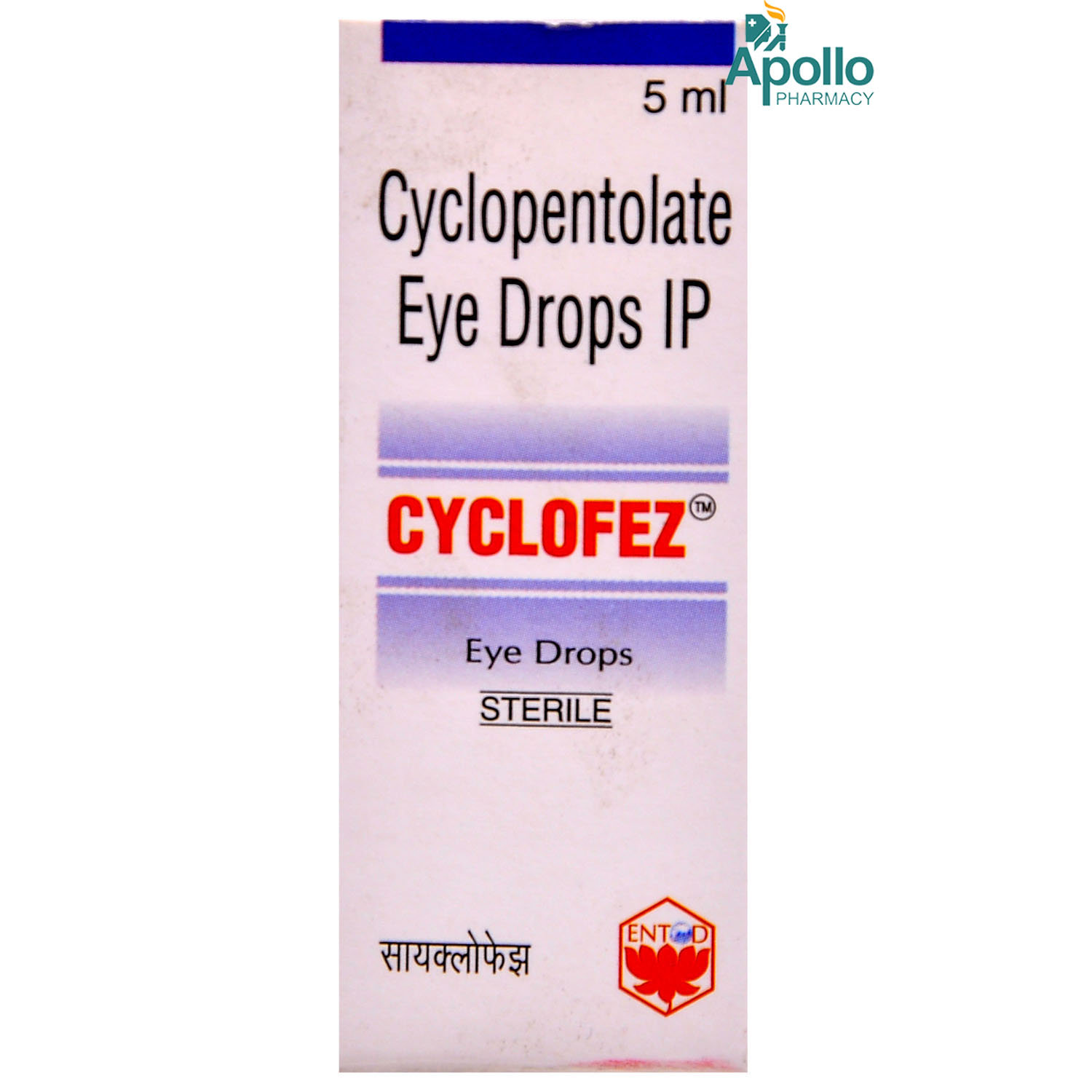Cyclopentolate
About Cyclopentolate
Cyclopentolate belongs to the class of ocular medications called mydriatic-anticholinergic used to enlarge the pupil of the eye (preventing the eye from focusing) and to paralyze the lens temporarily before an eye examination or surgery. It is also used to treat eye inflammation (uveitis) and reduces inflammation (redness and swelling) after cataract surgery.
Cyclopentolate contains Cyclopentolate that works by temporarily dilating (widening) the pupil of the eye and relaxing the muscles of the eye. It can also be prescribed to treat inflammation and pain within the eye. Cyclopentolate makes the pupil larger and relaxes the muscles in the eye, which reduces pain and allows the inflamed part of the eye to rest and recover.
Cyclopentolate is for external (in the eyes) use only. Use Cyclopentolate as prescribed by your doctor. You may experience eye irritation, foreign body sensation in the eyes, blurred vision, eye itching, stinging, increased intraocular pressure, and burning sensation in the eye in some cases. Most of these side effects of Cyclopentolate are temporary, do not require medical attention, and gradually resolve over time. However, if the side effects are persistent, reach out to your doctor.
Before using Cyclopentolate, inform your doctor if you are allergic to Cyclopentolate, have high pressure of the liquid inside the eye (closed-angle glaucoma), Down's syndrome, brain damage or spastic paralysis (in children), or have heart disease. Inform your doctor if you are pregnant or breastfeeding before using Cyclopentolate. Please consult your doctor if Cyclopentolate is to be used in children. Infants and young children may more likely have side effects like behavioural disturbances from Cyclopentolate. Caution is advised when using Cyclopentolate in the elderly because they may be more sensitive to side effects, especially increased pressure in the eye. Cyclopentolate can cause blurred vision for up to 24 hours after using it. Be careful if you drive or do anything that requires you to be able to see clearly. This medicine may also make your eyes more sensitive to light. Until the effects wear off, protect your eyes from the sun or bright light.
Uses of Cyclopentolate
Medicinal Benefits
Cyclopentolate contains Cyclopentolate is an anticholinergic drug primarily used before eye examinations (refraction exams). Cyclopentolate works by temporarily dilating (widening) the pupil of the eye and relaxing the muscles of the eye. It can also be prescribed during the treatment of a condition called anterior uveitis. This is a painful eye condition caused by inflammation and pain within the eye. Cyclopentolate makes the pupil larger and relaxes the muscles in the eye, which reduces pain and allows the inflamed part of the eye to rest and recover.
Directions for Use
Storage
Side Effects of Cyclopentolate
- Eye irritation
- Foreign body sensation in the eyes
- Blurred vision
- Itchy eye
- Stinging of eyes
- Increased intraocular pressure
- Burning sensation in the eyes
Drug Warnings
If you are allergic to Cyclopentolate or any other medicines, please tell your doctor. If you have high pressure of the liquid inside the eye (closed-angle glaucoma), Down's syndrome, brain damage or spastic paralysis (in children), or heart disease, inform your doctor before using Cyclopentolate. Please inform your doctor if you are pregnant or breastfeeding before starting Cyclopentolate. Cyclopentolate is not recommended for children below 28 days old as safety and effectiveness have not been established. Caution is advised when using Cyclopentolate in infants or small children and the elderly because they may be more sensitive to side effects of this drug, especially increased pressure in the eye. Also, inform your doctor about all other medications you have been taking before using Cyclopentolate. Your doctor will ask you to remove your contact lenses before administration of the drops. Therefore, do not wear your contact lenses until the effects of the drops have completely worn off. After you apply Cyclopentolate, your vision may become temporarily blurred. Do not drive, use machinery or do any activity that requires clear vision until you are sure you can perform such activities safely. Cyclopentolate may make your eyes more sensitive to light. Protect your eyes in bright light, and use dark sunglasses when outdoors.
Drug Interactions
Drug-drug interactions: Cyclopentolate interacts with a medicine used to treat dementia (donepezil), antipsychotics (clozapine), and cholinergic agonists (methacholine, acetylcholine ophthalmic, bethanechol, carbachol ophthalmic).
Drug-food interactions: No interactions found.
Drug-disease interactions: Cyclopentolate should not be used in patients with angle-closure glaucoma, Down's syndrome, brain damage or spastic paralysis (in children), or heart disease.
Drug-Drug Interactions Checker List:
Safety Advice

Alcohol
cautionAvoid alcohol while using Cyclopentolate.

Pregnancy
cautionCyclopentolate is a pregnancy Category C medicine. It is not known whether Cyclopentolate can be used in pregnancy. Hence, it should be taken only when prescribed by a doctor if he/she thinks the benefits outweigh the risks.

Breast Feeding
cautionIt is unknown if Cyclopentolate passes into breastmilk. Consult your doctor before taking Cyclopentolate if you are breastfeeding.

Driving
cautionCyclopentolate may cause vision problems. However, it will be mild and temporary. So, it is advisable to avoid driving until your vision clears.

Liver
safe if prescribedCyclopentolate can be used for treating eye infections in patients with liver diseases.

Kidney
safe if prescribedCyclopentolate can be used for treating eye infections in patients with kidney diseases.

Children
cautionCyclopentolate should be used with caution in children. It is not recommended for use in newborns.
Habit Forming
Diet & Lifestyle Advise
- Try to maintain good hygiene to keep your eyes clean and irritant-free.
- Do not rub your eyes even though some ophthalmic drugs make your eye itchy.
- Know your allergy triggers, such as pollen, dust and other factors.
- Sleep for at least six to eight hours to rejuvenate your eyes naturally.
- Wash your eyes with clean water at least two to three times a day
- Manage stress, eat healthily, drink plenty of water, exercise regularly and get plenty of sleep.
- Wash your hands thoroughly, and do not touch the dropper before using drops to avoid contamination.
- Reduce screen time (by avoiding watching tv or phone) and use sunglasses while going into the sunlight.
Special Advise
- Protect your eyes in bright light, and use dark sunglasses when outdoors.
- Caution is advised when using Cyclopentolate in infants or small children and elderly patients, they may be more sensitive to the side effects, especially mental/mood changes and increased pressure in the eye.
Patients Concern
Disease/Condition Glossary
Uveitis: Uveitis is an inflammation of the middle layer of the eye (uvea). The most common type is an inflammation of the iris called iritis (anterior uveitis). Symptoms include eye redness, pain and blurred vision.
FAQs
Cyclopentolate contains Cyclopentolate that works by temporarily dilating (widening) the pupil of the eye and relaxing the muscles of the eye. It can also be prescribed to treat inflammation and pain within the eye.
Do not wear contact lenses while using Cyclopentolate. Wait before wearing the contact lens, at least until the effects of the drops have completely worn off.
The common side effects of Cyclopentolate are eye irritation, foreign body sensation in eyes, blurred vision, eye itching, stinging, increased intraocular pressure, and burning sensation in the eye. These side effects are mild and temporary.
Cyclopentolate may take about half an hour or more to fully work after using it. Effects may last for up to 24 hours but may last depending on your disease condition.
Cyclopentolate can cause blurry vision for some time in the beginning. Avoid driving and operating machinery in such cases until you feel better. If the effect persists longer, seek medical attention.







